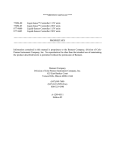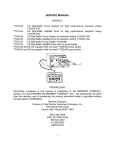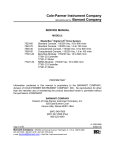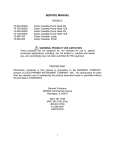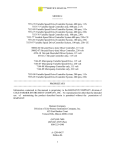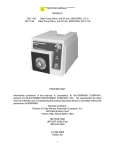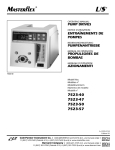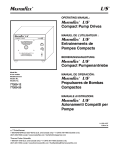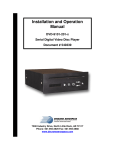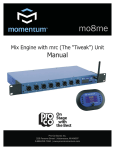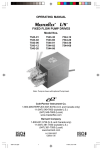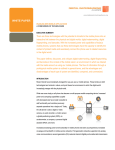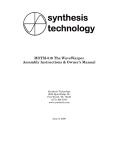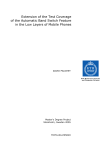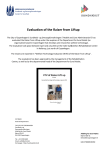Download service manual
Transcript
********SERVICE MANUAL*********
7520-40
7520-47
7520-50
7520-57
7520-60
7520-67
77521-40
77521-47
77521-50
77521-57
MODELS:
-------------Unified Masterflex Drive, 600 RPM, 115 V
Unified Masterflex Drive, 600 RPM, 230 V ce
Unified Masterflex Drive, 100 RPM, 115 V
Unified Masterflex Drive, 100 RPM, 230 V ce
Unified Masterflex Drive, 300 RPM, 115 V
Unified Masterflex Drive, 300 RPM, 230 V ce
Unified Masterflex Drive, w/4-20 mA, 600 RPM, 115 V
Unified Masterflex Drive, w/4-20 mA, 600 RPM, 230 V ce
Unified Masterflex Drive, w/4-20 mA, 100 RPM, 115 V
Unified Masterflex Drive, w/4-20 mA, 100 RPM, 230 V ce
900-1076
900-1077
900-1268
900-1273
900-1274
OEM Drive MILLIPORE, 600 RPM, 115 V
OEM Drive MILLIPORE, 600 RPM, 230 V ce
OEM Drive Drive Tech 300 RPM, 115 V
OEM Drive Spectrum Pump System, 600 RPM, 115 V
OEM Drive Spectrum Pump System, 600 RPM, 230 V ce
1
PROPRIETARY
Information contained in this manual is proprietary to the BARNANT COMPANY, division of
COLE-PARMER INSTRUMENT COMPANY, INC. No reproduction for other than the intended
use of maintaining the product described herein is permitted without the permission of BARNANT.
Barnant Company
Division of Cole-Parmer Instrument Company, Inc.
625 East Bunker Court
Vernon Hills, Illinois 60061-1844
(847)549-7600
(847)247-2929 (Fax)
800-323-4340
A-1299-0934
Edition 02
2
TABLE OF CONTENTS
------------------------------PAGE
INTRODUCTION…………… ………………………………………………………………...4
SAFETY CONSIDERATIONS…………………………………………………………………5
THEORY OF OPERATION…………………………………………………………………….6
DETAILED CIRCUIT OPERATION OF CONTROLLER BOARDS……………….……….7-12
TROUBLESHOOTING……………………………………………………………………….…13
REPAIR PROCEDURES………………………………………………………………………...14-17
REPLACEMENT PARTS LISTING ...................................................................................... 18-19
CALIBRATION PROCEDURE....................................................................................................20
FUNCTIONAL TEST ...................................................................................................................22
SPECIFICATIONS.................................................................................................................. 23-24
APPENDIX:
OLD SERVICE MANUAL (A-1299-0442) for 7520-xx drives manufactured before the date code
outlined on the next page.
3
---------------------------------------------------------------INTRODUCTION
----------------------------------------------------------------
This service manual is written to cover the Re-Designed 7520-xx series drives. The new
drives can be identified by the manufactures use of a “gold colored chassis”. The previous products
had black chassis. The 7520-xx have similar electronics hardware.Service techniques used on one
system will carry over to the other family. This also holds true for the OEM model numbers.
The 7520-xx and 900-xx series drives that were manufactured prior to H00005767
(excluding #’s H00001068 thru H00001114) as listed on the drives serial number code are covered
under the old service manual part number A-1299-0442 (see appendix).
Service for this product is performed at three levels: the customer, distributor/
COLE-PARMER and factory/depot repair. This manual describes distributor/COLE-PARMER
service procedures.
Customer service procedures are described in the operator’s manual. Customers are
encouraged to perform service as described in the operators manual as well as in special
circumstances where special skills and safety are not considerations.
To use this manual, begin with the troubleshooting section to isolate the fault to a replaceable
part. The functional description and checkout procedure sections are also helpful in determining the
faulty part. Distributor/COLE-PARMER repair is limited to replacement of modules as detailed in
the replacement parts list section. The repair procedure section details disassembly and assembly
procedures. After repair, the product should be calibrated and checked for proper performance.
Please refer to the operators' manual (PT: #A-1299-0860) for:
A.) APPLICATIONS DATA
B.) PRODUCT DESCRIPTION
C.) INSTALLATION
D.) SETUP
E.) OPERATION
F.) USER CALIBRATION
G.) USER TROUBLESHOOTING & MAINTENANCE
H.) ACCESSORIES
I.) SPECIFICATIONS
4
---------------------------------------------------------------S A F E T Y C O N S I D E R A T I O NS
---------------------------------------------------------------Servicing must be performed only by personnel trained and skilled in the methods of
troubleshooting and repair of electro-mechanical products. Use of procedures other than those
described in this manual may result in a safety hazard to service personnel and/or customers.
When servicing any component of this unit be absolutely certain that all power to circuitry is
removed. If any functional checks are to be performed while power is applied and chassis is
disassembled, care must be exercised for the following:
WARNING!
A.) THIS IS A LINE OPERATED DEVICE AND IS NOT ISOLATED FROM GROUND. USE OF
AN ISOLATION TRANSFORMER IS STRONGLY RECOMMENDED.
B.) DO NOT INADVERTENTLY SHORT ANY PART OF THE PRINTED CIRCUIT CARD TO
GROUND, AS SEVERE DAMAGE WILL RESULT.
C.) MAKE ABSOLUTELY SURE THAT ANY TEST EQUIPMENT USED FOR REPAIR IS NOT
REFERENCED TO EARTH GROUND.
5
---------------------------------------------------------------THEORY OF OPERATION
---------------------------------------------------------------The variable speed controller employs a phase-controlled rectifier bridge to vary the power
applied to a permanent magnet DC motor. The bridge will conduct current only when the power line
voltage exceeds the voltage across the motor terminals. Varying the point at which the bridge starts
to conduct relative to the phase of the line voltage can therefore control the power to the motor. An
inner torque, outer speed regulator loop, controls the phase angle at which the bridge starts
conducting. The speed of the motor is directly proportional to the back EMF generated by the motor.
Comparing the voltage across the motor terminals against the speed reference signal at the center tap
of the front panel speed control pot, an op amp generates a torque reference signal. The torque
supplied by the motor is directly proportional to the current supplied to the motor. The op amp
amplifies the voltage drop across a sense resistor, providing a signal proportional to the average
current supplied to the motor. The peak value of the signal is subtracted from the torque reference
signal by a transistor. The resulting torque error signal charges a capacitor, firing the power bridge
SCR's for a given line cycle.
Transient voltage suppression for the line is provided by “line to line” Mov`s. Motor brush
commutation noise is suppressed using a RC network.
600 volt SCR`s and 1000 volt diodes make up the power bridge and primary power supply.
Supply regulation is through a zener diode network. SCR switching at zero cross is actually centered
on a 10-volt window creating a secondary supply, allowing a complete shut-off of each SCR. This
voltage is also used to synchronize the SCR firing circuit to the line.
A simple RC network provides for a soft-start circuit, which provides a gentle acceleration of
the motor.
The 77521-xx series drives have an identical motor controller front end, with the addition of
linear speed control inputs. These two inputs take either 2 – 10 volt dc or 4 – 20 ma and operate the
drive over its full rated speed range.
The linear inputs generate a 1 – 5 volt span that is OP amp buffered for common mode up to
15 vdc. This voltage is than fed through an offset OP amp to subtract 1 volt from the signal, leaving
0 – 4 volt control signal for speed reference. MOS switches select either the front panel control
reference voltage or the linear input speed reference to control drive speed. This stage also
incorporates an additional MOS switch that allows contact closure (start/stop) control of the drive
motor. Additional circuitry allows the user to remotely select the front panel or linear input speed
references using a contact closure.
The output of the commanded 4-20 mA and 2-10 VDC inputs are optically isolated from the ac line,
minimum 1250 Vac for 115Vac units, 1900 Vdc for 230Vac units.
6
---------------------------------------------------------------DETAILED CIRCUIT OPERATION
7520-XX SERIES CONTROLLERS
---------------------------------------------------------------GENERAL OVER-VIEW
A.) The 7520 series controller board employs modular SMT technology (see figure #1) to
provide a single board solution, employing an SCR based power amplifier to drive permanent
magnet motors up to .1 HP.
Power Supply
A.) AC line is brought in at (J-3 and J-4) and routed through ("FWD: OFF: REV") switch contacts to
power bridge consisting of (CR1-CR4).
B.) 100 VDC at (TP #8), is dropped by series resistor (R-26) and regulated to approximately 22.7
VDC at (TP #6) by (CR-7).
C.) LED (DS-1) indicates power "ON" to circuitry.
D.) Varistor VR1 and RC network R1 & C1 suppress line noise generated externally and internally
by motor and power bridge.
Output Drive
A.) Motor power bridge consists of (CR-3, CR-4, Q-1, Q-2). Diode (CR-5) bypasses the inductive
current surges of the motor when the Power Bridge shuts off. The output bridge is routed
through ("FWD: OFF: REV") switch contacts to allow motor reversal and is brought out at (J-1
and J-2) of the PCB.
B.) Resistor capacitor combination consisting of (R-5 and C-2) forms a snubber network for
commutation noise suppression.
Control Section
A.) Motor speed is set by front panel pot connected to J6.
B.) A +VREF is obtained by regulating the +22VDC supply with (R-13 and CR-11) to
approximately +12VDC. This is routed through network (R-33 and R-30) to DC ground.
Adjustment pot. (R-33) sets maximum motor speed approx. +10VDC at (TP-1).
C.) Components (R-13, CR-9, and C-6) control acceleration, deceleration of motor RPM.
7
D.) Set-speed is controlled and regulated by differential amp (U1) and related components (R-15,
C-7, R-17, and R-2, R-37, R-3). All scaling is done at 5volts full-scale for all op amp circuits. As
motor load increases, back EMF, picked off drive output resistor network (R-2, R-37 and R-3),
(TP-3) decreases from 5 volts. This is fed through (R-17) to pin 2 of (U1-A) causing (TP-2) to
charge integrator capacitor (C-10) via (R-18) to advance the SCR firing angle, until the op amp
equalizes its input voltages.
E.) Current limit of circuit is accomplished by monitoring the voltage drop of current sense resistor
(R-4), feeding it through (R-19 and R-11) to level amp (U1-B) and related components. As
current through (R-4) approaches [2.0 amps for 120 volt units]; [1.0 amps for 240 volt units]
voltage to (TP-4) rises to approximately +5.0VDC. This is fed through resistor network (R-22
and R-23) at a [2 to 1] ratio, into the peak detector (CR-10 & C-9). The output of the peak
detector is buffered (R-21 & Q-4) by an emitter follower (Q-4 & R-25) amplifier which
discharges integrator (C-10), retarding the SCR firing angle. The resultant firing angle will be
proportional to the difference between the torque reference charging current (R-18) and the
torque feedback discharging current (R-25).
F.) The SCR will fire when the integrator (C-10) voltage is equal to the"PUT" (Q-9) reference
voltage (VR-3: R-11; &R-12). Line synchronization is achieved by allowing the reference
voltage to drop to zero (10-volt window) with each line cross, thereby discharging (C-10)
through (Q-9). (C-10 & Q-9) form a relaxation oscillator whose period is proportional to the rate
of charge of (C-10). When the voltage across (C-10) is equal to the reference voltage, the
"PUT"(Q-5) is forward biased and will conduct, discharging (C-10) through the base-emitter
junction of buffer (Q-6). (R-9) bypasses any leakage current, while (C-11) filters out noise
pulses.
G.) The pulse output of the relaxation oscillator (C-10 & Q-9) is buffered and amplified by (Q-6)
and level shifted by a Darlington pair (Q-3 & Q-8) on 115-volt units or (Q-8 & Q-7) on 220-volt
units’ fire the Power Bridge SCR (Q-1 & Q-2). (R-7 & R-29) limits the gate current, while
(CR-6 & CR-12) blocks back conduction of the Darlington pair.
H.) For a detailed view of these signals see figure #3 waveform and related descriptions.
8
---------------------------------------------------------------DETAILED CIRCUIT OPERATION
77521-XX SERIES CONTROLLERS
---------------------------------------------------------------GENERAL OVER-VIEW
A.) The 77521 series controller board employs modular SMT technology (see figure #2) to
provide a single board solution, employing an SCR based power amplifier to drive permanent
magnet motors up to .1 HP. This board also incorporates circuitry to allow remote speed control
through voltage or current as well as control through contact closures. All of the board features
of the 7520 are used in this design, therefore the detailed descriptions of circuitry that follow will
only outline the major differences between the two.
Power Supply
A.) The +22 volt non-isolated supply is derived by 100 VDC at (TP #8), dropped by resistor network
(R117, R132, R133, R134, R135, R136) these are multiple smt style resistors and regulated to
approximately 22 VDC at (TP #6) by (VR4). The voltage will charge (C5) through CR8) to filter
the ripple and produce a regulated supply.
B.) The +15 volt non-isolated supply is derived by tapping off (C5) through (R33) and regulated by
(VR2). Capacitor (C16) filters any ripple.
C.) A separate +15 volt supply used to drive the circuitry on the isolated side of the circuits is
derived for transformer (T1), rectified by (D1-D4), filtered and bypassed by (C23-C24), then fed
into regulator (U8). The 15 volts is set by (R106-R107) and filtered by (C20). This voltage is
available at (J16 pin#1).
Control Section
In this controller all user adjustable controls e.g. speed pot and remote features are isolated from the
ac line. The final output from the opto coupler isolator drives the input of the aforementioned
controller.
A.) Motor speed is set by front panel pot connected to J8.
B.) Front panel speed reference voltage is generated by divider network (R65, R56, and R53) to DC
ground. Adjustment pot (R-65) sets maximum motor speed approx. +4.0VDC at (J16 pin3).
C.) The 4 volt signal that is set above is routed through analog switch network (SW1-A & SW1C)
which is the selection network for front panel speed or remote speed select and the foot switch
control. Switch (SW1-A) works opposite of (SW1-B) when local remote switch is in the LOCAL
position a low is placed at pin5 (SW1-B) turning it off. The low is prevents conduction of (D8)
allowing pull-up (R75) to enable (SW1-A) selecting the front panel speed reference. When local
remote switch is in the REMOTE position a high is placed at pin5 (SW1-B) turning it on
selecting the remote speed inputs. The high causes conduction of (D8), transistor (Q11)
conducts, pulling pin13 (SW1-B) low deselecting the front panel speed reference. In this mode
the user can select either front panel or remote speed references by grounding (J6 pin4 interface
connector).
D.) The foot switch control works in a similar manner as above. When local remote switch is in the
REMOTE position a low is placed at pin6 (SW1-B) turning it off. The low is generated by (Q10)
conduction through (D7) pull-up (R70) this prevents the speed reference voltage (regardless of
front panel or remote selection) from driving the opto coupler isolation drive.
9
By grounding (J6 pin7 interface connector) the low prevents conduction of (D7), transistor (Q10)
turns off, allowing pull up (R73) to enable (SW1-C) allowing the speed reference voltage selected to
drive the opto coupler isolation drive.
E.) The opto coupler isolation drive consists of (OPT1) and U4-B) this circuit works by taking a
voltage at pin5 (U4-B) and having the output of the op amp drive the input ird led of (OPT1)
until the op amp equalizes its input voltages at pin6. Because there is are two detectors within
opt1 one is within the feedback path, another in a separate op amplifier (U5-B). A linear drive
voltage will give a linear output of the same voltage, pin7 (U5-B). This control voltage typically
0 – 10 volts will drive the SCR amplifier input. This circuit also serves to provide isolation
barrier of approx. 3500 volts between the grounded and hot referenced control circuits.
F.) The linear inputs consist of (U3-A) dual op amp. This is split one for voltage one for current.
The +voltage input enters pin1 (J6) and ground pin3 (J6) through (R78). The voltage across R78
is divided by 2 and buffered by (U3-A), to generate a 1 – 5 volt output. The +current input enters
pin2 (J6) and ground pin3 (J6) through (R47). The voltage across R47 is buffered by (U3-B), to
generate a 1 – 5 volt output.
G.) Because the scaling of the electronics the outputs of the above circuits have to start at “zero” and
then span. This is accomplished by setting (U4-A) for an offset of 1 volt. The result is a 0 – 4
volt control signal.
H.) (D13) is configured as an adjustable zener diode. This will conduct at 6 volts to clamp off (U3A) outputs of greater than 5 volts, preventing excessive drive speed.
10
Figure 1 Typical controller board employed in the 7520 series drives.
Figure 2 Typical controller board employed in the 77521 series drives.
11
Figure 3
1. Waveform #1 Test point #6
Follow for operation
2. Waveform #2 Output of scr bridge across motor
3. Waveform #3 PUT charging ramp test point #5
4.
Waveform #4 Motor current measured using TEK #TPC-202 current probe
12
---------------------------------------------------------------TROUBLESHOOTING
----------------------------------------------------------------Repairs on this unit are basically confined to either the unit's control PCB and/or the drive
motor assembly.
Where possible, swap "known good" parts to localize and isolate the problem. The
following is a list of possible problems and remedies:
UNIT DOES NOT TURN ON; NO POWER LIGHT:
1.
2.
3.
4.
Fuse blown
-replace fuse
Power cord not connected properly
-check & replace
FWD-OFF-REV switch failure
-replace main controller PCB
Unit connected to dead outlet
-verify supply is HOT
UNIT BLOWS FUSES:
1. Motor drive failure
2. Defective controller PCB
3. Wrong fuse installed
-check using known good motor
-replace/return to factory
-check fuse rating
MOTOR WILL NOT REVERSE:
1. Defective FWD-OFF-REV switch
-replace switch assy.
MOTOR WILL NOT RUN: (assumed functional motor)
1. Defective FWD-OFF-REV switch
2. Defective controller PCB ASSY.
-replace switch assy.
-Replace main controller PCB ASSY.
LOSS OF SPEED CONTROL OR IMPROPER SPEEDS:
1. Defective controller PCB ASSY.
2. Unit out of calibration
-Replace main controller PCB ASSY.
-recalibrate controller
MOTOR IMMEDIATELY RUNS WHEN POWER IS APPLIED:
1. Power output triacs shorted
-replace main controller PCB ASSY.
For additional information regarding the unit, please refer to the following:
A-1299-0860 operators manual
13
----------------------------------------------------------------REPAIR PROCEDURES
----------------------------------------------------------------
TO DISASSEMBLE UNIT, PROCEED AS FOLLOWS:
As pictured, remove the six Phillips screws (three from each side) from the cover assembly.
Figure 4
Position cover and chassis as shown. Be very care full not to let any switch terminals ground out
to chassis.
TO REASSEMBLE UNIT, PROCEED AS FOLLOWS:
14
A.) Reverse the above steps insuring that no wiring is pinched. The wiring harnesses should be
formed as an upside down “P TRAP” position inside the enclosure.
TO REPLACE MAIN CONTROL PCB ASSEMBLY (7520):
A) Follow the steps outlined in "DISASSEMBLE UNIT".
B.) Disconnect the wiring and hardware as shown in picture.
Potentiometer to front panel
Led indicator to front panel
FWD/REV switch
AC line
Motor connections
Max speed ADJ. (R33)
C.) Replace control board noting wiring.
D.) Check calibration as per applicable CAL. specifications.
E.) Follow the steps outlined in "ASSEMBLE UNIT".
TO REPLACE MAIN CONTROL PCB ASSEMBLY (77521):
15
A.) Follow the steps outlined in "DISASSEMBLE UNIT".
B.) Disconnect the wiring and hardware as shown in picture.
Potentiometer to front panel
Led indicator to front panel
FWD/REV switch
AC line
Motor connections
Max speed ADJ. (R90)
C.) Replace control board noting wiring.
D.) Check calibration as per applicable CAL. specifications.
E.) Follow the steps outlined in "ASSEMBLE UNIT
T0 REPLACE MOTOR
16
A.) Follow the steps outlined in "DISASSEMBLE UNIT".
B.) Remove groundnut and wires from PCB noting wiring.
C.) Loosen motor mounting bolts.
D.) Slide motor forward and remove from chassis.
E.) Install new motor. Reattach ground and motor leads. Slide motor back and tighten bolts.
TO REPLACE SPEED POTENTIOMETER:
A.) Remove knob and mounting hardware.
B.) Slide pot. Assembly out of enclosure.
C.) Install new pot. Assembly in reverse sequence.
D.) Verify that when the knob is turned fully counter-clockwise, the indicator line is at 7:00
TO REPLACE FWD-OFF-REV SWITCH:
A.) Remove switch sealing boot, using care to prevent damage to it.
B.) Slide switch assembly out of control panel, noting which side keyway slot on bushing is facing.
C.) Insert switch assembly into control panel with keyway slot in proper direction, reinstall boot and
tighten until switch will not rotate.
TO REASSEMBLE UNIT, PROCEED AS FOLLOWS:
A.) Carefully plug all connectors into PCB observing proper orientation of plugs.
17
----------------------------------------------------------------REPLACEMENT PARTS LISTING
----------------------------------------------------------------The following is a list of stockable, motor assemblies, main control PCB assemblies, and
their reference schematic diagrams for all indicated models:
-MODELSMotor Assembly #
MODEL #
MAX. RPM
7520-40
7520-50
7520-60
7520-47
7520-57
7520-67
900-1076
900-1077
900-1268
900-1273
900-1274
600RPM; 115V
100RPM; 115V
300RPM; 115V
600RPM; 230V
100RPM; 230V
300RPM; 230V
600RPM; 115V
600RPM; 230V
600RPM; 115V
600RPM; 115V
600RPM; 230V
5870-0021-CR
5871-0007-CR
5870-0021-CR
5870-0012-CR
5871-0008-CR
5870-0012-CR
5870-0021-CR
5870-0012-CR
5870-0013-CR
5870-0021-CR
5870-0012-CR
E-2219-0006-CR
E-2219-0006-CR
E-2219-0008-CR
E-2219-0007-CR
E-2219-0007-CR
E-2219-0009-CR
E-2219-0006-CR
E-2219-0009-CR
E-2219-0008-CR
E-2219-0006-CR
E-2219-0007-CR
REFERENCE
SCHEMATIC
E-2193
E-2193
E-2193
E-2193
E-2193
E-2193
E-2193
E-2193
E-2193
E-2193
E-2193
77521-40
77521-50
77521-47
77521-57
600RPM; 115V
100RPM; 115V
600RPM; 230V
100RPM; 230V
5870-0021-CR
5871-0007-CR
5870-0012-CR
5871-0008-CR
E-2274-0003-CR
E-2274-0003-CR
E-2274-0004-CR
E-2274-0004-CR
E-2268
E-2268
E-2268
E-2268
18
PCB#
The following is a list of commonly used parts applicable to the above model LISTINGS:
DESCRIPTION
BARNANT Part#
Speed adjustment knob (7520) (900-1273, 900-1274)
Speed adjustment knob (77521) (900-1076/1077/1268)
FWD-OFF-REV switch assembly (115 volt Non-CE models)
FWD-OFF-REV switch assembly (230 volt CE models)
Switch sealing boot (all models)
B-1083-0056
A-2583
5632
5775
A-2984
Speed pot. Assembly single turn (7520) (900-1273, 900-1274)
5655-0001
Speed pot. Assembly ten turn (77521) (900-1076/1077/1268)
T3.15 5 x 20 MM fuse (115V systems)
T1.16 5 x 20 MM fuse (230 V systems)
Rubber foot on chassis
5633-0001
B-1115-0057
B-1115-0042
B-1390-0002
19
---------------------------------------------------------------CALIBRATION
---------------------------------------------------------------After repairs are made, the unit must be tested to assure proper performance to specifications.
In many cases servicing personnel to accomplish this can use factory/QC checkout procedures.
For calibration procedures please refer to the following (CAL-SPECIFICATION) listings
table appropriate to the model that is being serviced.
MODEL#
7520-40
7520-47
7520-50
7520-57
7520-60
7520-67
77521-40
77521-47
77521-50
77521-57
CAL-SPECIFICATION #
CAL #1834
MODEL#
900-1076
900-1077
900-1268
900-1273
9001274
CAL-SPECIFICATION#
CAL #1834
CAL #1836
Additional technical specifications are available in the unit's OPERATOR MANUAL.
Because this manual is covering approximately 15 different models, exact calibration
procedures will differ between each unit. However the following procedure may be used to roughly
tweek an out-of-spec. unit.
20
BEFORE PROCEEDING FURTHER PLEASE NOTE ALL WARNINGS AS LISTED IN THE
"SAFETY CONSIDERATIONS SECTION"!!!
------------------------TOOLS REQUIRED
------------------------A.) #1 Phillips screwdriver
B.) Non-metallic pot-tweaker
C.) Hand-held tachometer
-----------------------Proceed as follows:
-----------------------1.) Follow procedure for unit dissasembly.
2.) Plug unit into the appropriate line voltage. If this can be done through an adjustable variac, to
e.g. 115 vac (115 volt units) or 230 vac (230 volt units).
3.) Turn unit on, set speed control for maximum.
4.) Measure & turn pot (R-90) E-2274-0003 & -0004 series PC Boards; (R-33) E-2219-xxxx series
both pots are (multi-turn) to obtain proper motor terminal voltage as follows:
100.0 vdc +/- .5 vdc (for 115 vac units)
200.0 vdc +/- 1.0 vdc (for 230 vac units)
5.) All other pots are factory adjusted and should not be field adjusted.
6.) Seal pot adjustments and reassemble unit.
--------------------------------------------------------------21
FUNCTIONAL TESTS
---------------------------------------------------------------A.) Mate drive motor to specified controller.
B.) Power up controller at specified line voltage.
C.) Verify that controller drives motor properly.
D.) Refer to the "CALIBRATION" Section for additional information regarding the controller.
22
---------------------------------------------------------------SPECIFICATIONS
---------------------------------------------------------------Power
Supply Voltage (per DSM 8806): 90-130 Vrms or 190-260 Vrms, 50/60 Hz, Single Phase
IEC 664 Installation Category II (Appliances and portable equipment powered from local
branches)
All drives use modular line cords with IEC 320/CEE 22-connector coupler. Female line
cord/male socket. Alternative Line cords is available as Model numbers:
50001-68 (USA-115V, Japanese), 50001-70 (European),
50001-60 (Australia), 50001-62 (Denmark), 50001-64 (India), 50001-66 (Israel),
50001-72 (British), 50001-74 (Swiss), 50001-76 (Italian), 50001-78 (USA-230V)
Motor Power:
0.10 hp
(Maximum at output shaft)
Drive Current, Max.
115 Vrms:
230 Vrms:
2.3 A
1.2 A
Control Circuit Power: 6 watts, maximum dissipation.
4.3.2 Remote Start/Stop & Remote/Local
The remote control inputs work with current sinking outputs (open-collector NPN transistor
outputs with or without passive pull-up resistors) or contact closures to DC common (earth
ground). A continuous active low to the Remote Start/Stop input causes the drive to run,
while a continuous active low to the Remote/Local input switches speed control to the front
panel speed control.
High State:
Low State:
Input_Voltage
15 VDC Typ.
0.8 VDC Max.
Input_Current
100 µA Max. leakage
1.5 mA Max.
All inputs will be electrically isolated from the ac line, minimum 1250 Vac for 115Vac units,
1900 Vdc for 230Vac units.
23
4.3.3 Remote Analog Input (Ref.: ISA-S50.1)
4-20 mA Input:
250 ohms typical input impedance referenced to signal ground.
4 mA, Stop; 20 mA, Full Speed
Accuracy: 3% F.S., Linear Resolution
Overload Capability: 10 V or 40 mA max.
2-10 V Input:
10 K ohms typical input impedance referenced to signal ground.
2 V, Stop; 10 V, Full Speed
Accuracy: 3% F.S., Linear Resolution
Overload Capability: 15 V max.
Only one of the analog inputs may be used at any one time. The front end of the circuit is a
differential op amp to allow for multiple units (max 3) to be cascaded in series (Current
Input) or parallel (Voltage Input) for control. Both 4-20 mA and 2-10 VDC inputs are
optically isolated from the ac line, minimum 1250 Vac for 115Vac units, 1900 Vdc for
230Vac units.
4.4
ENVIRONMENTAL INPUTS (ref.: DSM 8806)
Indoor Use - Nonmobile, laboratory or office environment readily accessible to
maintenance. Normally only non-conductive pollution occurs, but a temporary conductivity
caused by condensation must occasionally be expected (IEC 664 Pollution Degree 2).
4.4.1 Operating Temperature:
Storage Temperature:
Humidity: (non-cond.)
Altitude:
Minimum
0 °C
-45 °C
10 %
-
Maximum
40 °C
65 °C
90 %
2000 m
4.4.2 Chemical resistance. All materials withstand standard cleaning solvents. Materials
used in the construction are:
ABS plastic case with a polyester label, gold, irridite-coated aluminum chassis, and
zinc-plated screws.
4.4.3 Vibration: Withstands standard freight shipment (Rail, Air, Sea, and Paved Roads)
when packed in specified shipping container (Secured Cargo).
Electromagnetic Compatibility (EMC): Meets immunity requirements of EN 61326-1/A1:
1998 for residential, commercial and light industry applications to comply with EC EMC
Directive for the European Union “CE” mark.
24
APPENDIX:
********SERVICE MANUAL********
MODELS:
7520-40 Unified Drive System, 600 rpm, 115v [single turn]
7520-45 Unified Drive System, 600 rpm, 230v [single turn]
7520-47 Unified Drive System, 600 rpm, 230v [single turn] "CE" mark
7520-50 Unified Drive System, 100 rpm, 115v [single turn]
7520-55 Unified Drive System, 100 rpm, 230v [single turn]
7520-57 Unified Drive System, 100 rpm, 230v [single turn] "CE" mark
7520-60 Unified Drive System, 300 rpm, 115v [single turn]
7520-65 Unified Drive System, 300 rpm, 230v [single turn]
PROPRIETARY
Information contained in this manual is proprietary to the BARNANT COMPANY, division of
COLE-PARMER INSTRUMENT COMPANY, INC. No reproduction for other than the intended
use of maintaining the product described herein is permitted without the permission of BARNANT.
Barnant Company
Division of Cole-Parmer Instrument Company, Inc.
625 East Bunker Court
Vernon Hills, Illinois 60061-1844
(847)549-7600
(847) 247-2929 (Fax)
800-323-4340
A-1299-0442
Edition 04
25
TABLE OF CONTENTS
SAFETY CONSIDERATIONS-------------------PAGE 4
THEORY OF OPERATION-----------------------PAGE 5
DETAILED CIRCUIT OPERATION------------PAGE 6 - 7
TROUBLESHOOTING----------------------------PAGE 8
REPAIR PROCEDURES--------------------------PAGE 9
REPLACEMENT PARTS LISTING-------------PAGE 10
CALIBRATION PROCEDURE-------------------PAGE 11 - 12
FUNCTIONAL TEST------------------------------PAGE 13
FUNCTIONAL SPECIFICATIONS--------------PAGE 14
26
INTRODUCTION
Service for this product is performed at three levels: the customer,
distributor/COLE-PARMER and factory/depot repair. This manual describes
distributor/COLE-PARMER service procedures.
Customer service procedures are described in the operators manual. Customers are
encouraged to perform service as described in the operators manual as well as in special
circumstances where special skills and safety are not considerations.
To use this manual begin with the troubleshooting section to isolate the fault to a
replaceable part. The functional description and check-out procedure sections are also helpful in
determining the faulty part. Distributor/COLE-PARMER repair is limited to replacement of
modules as detailed in the replacement parts list section. The repair procedures section details
disassembly and assembly procedures. After repair, the product should be calibrated and
checked for proper performance.
Please refer to the operators manual (pt# A-1299-0110) for:
A) APPLICATIONS DATA
B) PRODUCT DESCRIPTION
C) INSTALLATION
D) SETUP
E) OPERATION
F) USER CALIBRATION
G) USER TROUBLESHOOTING & MAINTENANCE
H) ACCESSORIES
I) SPECIFICATIONS
27
SAFETY CONSIDERATIONS
Servicing must be performed only by personnel trained and skilled in the methods of
troubleshooting and repair of electro-mechanical products. Use of procedures other than those
described in this manual may result in a safety hazard to service personnel and\or customers.
When servicing any component of this unit make absolutely sure that all power to
circuitry is removed. If any functional checks are to be performed while power is applied and
chassis is disassembled, care must be exercised for the following:
A) THIS IS A LINE OPERATED DEVICE AND IS NOT ISOLATED FROM
GROUND. USE OF A ISOLATION TRANSFORMER IS STRONGLY
RECOMMENDED.
B) DO NOT INADVERTENTLY SHORT ANY PART OF THE PRINTED CIRCUIT
CARD TO GROUND, AS SEVERE DAMAGE WILL RESULT.
C) MAKE ABSOLUTELY SURE THAT ANY TEST EQUIPMENT THAT IS USED
FOR REPAIR IS NOT REFERENCED TO EARTH GROUND.
28
THEORY OF OPERATION
The variable speed controller employs a phase-controlled rectifier bridge to vary the
power applied to a permanent magnet DC motor. The bridge will conduct current only when the
power line voltage exceeds the voltage across the motor terminals. The power to the motor can
therefore be controlled by varying the point at which the bridge starts to conduct, relative to the
phase of the line voltage. The phase angle at which the bridge starts conducting is controlled by
an inner torque, outer speed regulator loop. The speed of the motor is directly proportional to
the back EMF generated by the motor. Comparing the voltage across the motor terminals
against the speed reference signal at the center tap of the front panel speed control pot R-29,
U-1 generates a torque reference signal. The torque supplied by the motor is directly
proportional to the current supplied to the motor. U1 amplifies the voltage drop across a load
resistor, providing a signal proportional to the current supplied to the motor. The peak value of
the signal is subtracted from the torque reference signal by Q4. The resulting torque error signal
charges C10, firing Q6 and the power bridge SCR's.
VR1, R1, and C1 provide transient voltage protection from power line surges caused by
other power conversion equipment and lightning strikes. R5 and C2 provide transient protection
from surges created by motor brush noise and FWD/REV switching.
CR3, CR4, Q1, and Q2 form the main power bridge for the motor. CR5 provides a
current path to allow shut-off of SCR's Q1 and Q2. R2 and R3 provide voltage feedback and R4
provides current feedback to the regulator circuits. CR1 and CR2 with CR3 and CR4 form the
secondary power bridge for the power to the regulator circuits. R26 is a voltage dropping
resistor from line voltage to the +22V used by the regulators. CR7 limits the voltage to +22V.
CR6 decouples the pulsating DC, used to synchronize the SCR firing circuit to the line, from the
steady DC, filtered by C5, used to power the regulator circuits. R3 and CR1 stabilize the speed
reference signal. R11 and R12 provide the voltage reference and line synchronization for the
PUT Q5, used to fire the power bridge SCR's. R14, CR9, and C6 form the soft-start circuit
which provides a gentle acceleration of the motor. R31 and R16 compensate for the voltage drop
introduced by the motor armature resistance, thereby improving load regulation of the drive.
CR10 and C09 form a current peak detector which is buffered by R24 and Q04. Q6 and Q3 form
a pulse amplifier and level shifter to fire the power bridge SCR's. The SCR used for Q3 in the
220 vac units is configured to act like a high voltage PNP transistor.
29
DETAILED CIRCUIT OPERATION
Power Supply
A. AC line is brought in at (J-3 and J-4) and routed through ("FWD:OFF:REV") switch
contacts, to power bridge consisting of (CR1-CR4).
B. 100 VDC at (TP #8), is dropped by series resistor (R-26) and regulated to Approx. 22.7 VDC
at (TP #6) by (CR-7).
C. Green LED indicates power "ON" to circuitry.
D. Varistor VR1 and RC network R1 & C1 suppress line noise generated externally and
internally by motor and power bridge.
Output Drive
A. Motor power bridge consists of (CR-3, CR-4, Q-1, Q-2). Diode (CR-5) bypasses the
inductive current surges of the motor when the power bridge shuts off. The output bridge is
routed through ("FWD:OFF:REV") by (J-9, J-10, J-11, J-12, J-17, J-18) connecting switch
contacts to allow motor reversal and is brought out at (J-1 and J-2) of the pcb.
B. Resistor capacitor combination consisting of (R-5 and C-2) which forms a snubber network
for commutator noise suppression.
Control Section
A. Motor speed is set by panel mounted pot (R-29).
B. A +VREF is obtained by regulating the +22VDC supply with (R-13 and CR-11) to
approximately +12VDC. This is routed through network (R-28 and R-29) to DC ground.
Adjustment pot. (R-28) sets maximum motor speed approx. +10VDC at (TP-1).
C. Components (R-14, CR-9, C-6) control acceleration and deceleration of motor RPM.
D. Set speed is controlled and regulated by differential amp (U7-A) and related components
(R-15, C-7, R-17, R-2, R-3). As motor load increases back EMF picked off drive output resistor
network (R-2 and R-3), (TP-3) drops off. This is fed through (R-17) to pin 2 of (U1-A) causing
(TP-2) to charge integrator capacitor (C-10) via (R-18) to advance the SCR firing angle.
E. Current limit of circuit is accomplished by monitoring the voltage drop of current sense
resistor (R-4) feeding it through R-19 and R-20) to level amp (U1-B) and related components.
As current through (R-4) approaches [2.0 amps for 120 voltunits]; [1.0 amps for 240 volt units]
voltage to (TP-4) rises to approximately +4.0VDC. This is fed through resistor network
(R-22 and R-23) at a [2 to 1] ratio, into the peak detector (CR-10 & C-9). The output of the peak
detector is buffered (R-24 & Q-4) by an emitter follower (Q-4 & R-24) amplifier which
discharges integrator (C-10), retarding the SCR firing angle. The resultant firing angle will be
proportional to the difference between the torque reference charging current (R-18) and the
torque feedback discharging current (R-25).
30
F. The SCR will fire when the integrator (C-10) voltage is equal to the"PUT" (Q-5) reference
voltage (CR-7, R-11, & R-12). Line synchronization is achieved by allowing the reference
voltage to drop to zero with each line cross, thereby discharging (C-10) through (Q-5). (C-10 &
Q-5) form a relaxation oscillator whose period is proportional to the rate of charge of (C-10).
When the voltage across (C-10) is equal to the reference voltage, the "PUT" (Q-5) is forward
biased and will conduct, discharging (C-10) through the base-emitter junction of buffer (Q-6).
(R-9) bypasses any leakage current, while (C-11) filters out noise pulses.
G. The pulse output of the relaxation oscillator (C-10 & Q-5) is buffered and amplified by (Q-6)
and level shifted by (Q-3) on 115 volt units or SCR (Q-8) on 220 volt units to fire the power
bridge SCR (Q-1 & Q-2). (R-7) limits the gate current, while (CR-6) blocks back conduction of
(Q-3 or Q-8).
31
TROUBLESHOOTING
Repairs on this unit are basically confined to either the units control PCB and/or drive
motor assembly.
Where possible, swap in known good parts to localize and isolate the problem. The
following is a list of possible problems and remedies:
UNIT DOES NOT TURN ON;NO POWER LIGHT:
1. fuse blown
-replace fuse
2. power cord not connected properly
-check & replace
3. FWD-OFF-REV switch failure
-replace switch ASSY.
4. unit connected to dead outlet
-verify supply is HOT
UNIT BLOWS FUSES:
1. motor drive failure
-check using known good motor
2. defective controller pcb
-return/replace to factory
3. wrong fuse installed
-check fuse rating
MOTOR WILL NOT REVERSE:
1. defective FWD-OFF-REV switch
-replace switch ASSY.
MOTOR WILL NOT RUN: (assumed functional motor)
1. defective FWD-OFF-REV switch
-replace switch ASSY.
2. defective controller PCB ASSY.
-replace main controller PCB ASSY.
LOSS OF SPEED CONTROL, OR IMPROPER SPEEDS:
1. defective controller PCB ASSY. -replace main controller PCB ASSY.
2. unit out of calibration
-recalibrate controller
MOTOR IMMEDIATELY RUNS WHEN POWER IS APPLIED:
1. power output triacs shorted -replace main controller PCB ASSY.
FOR ADDITIONAL INFORMATION REGARDING THE UNIT PLEASE REFER
TO THE FOLLOWING: (A-1299-0110) operators manual
32
REPAIR PROCEDURES
TO DISASSEMBLE UNIT, PROCEED AS FOLLOWS:
A) Remove the three pan head screws on each side of the unit's cover.
B) Lift off molded housing.
TO REASSEMBLE UNIT, PROCEED AS FOLLOWS:
A) Slide on molded housing.
B) Install the three pan head screws on each side of the unit's cover.
TO REPLACE MAIN CONTROL PCB ASSEMBLY:
A) Follow the steps outlined in "DISASSEMBLE UNIT".
B) Replace main pcb assembly.
C) Note wiring of chassis as follows:
1) BROWN of corcom line filter to: J#3
2) BLUE of corcom line filter to: J#4
3) RED of drive motor to: J#1
4) BLACK of drive motor to: J#2
5) Follow steps in "TO REPLACE FWD-OFF-REV SWITCH"
[Note-switch does not have to be removed from housing.]
D) Check calibration per applicable CAL. specifications.
E) Follow the steps outlined in "ASSEMBLE UNIT".
TO REPLACE FWD-OFF-REV SWITCH:
A) Follow the steps outlined in "DISASSEMBLE UNIT".
B) Pull handle off switch ASSY.
C) Remove retaining hardware from switch.
D) Note wiring of chassis as follows:
1) ORANGE------------J#9
2) ORANGE\BLACK------J#10
3) YELLOW------------J#11
4) RED---------------J#12
5) BROWN-------------J#13
6) BLACK-------------J#14
7) GRAY--------------J#17
8) VIOLET------------J#18
9) BLACK\WHITE-------J#19
33
REPAIR PROCEDURES
The following is a list of stockable main control pcb assemblies, and their reference schematic
diagrams for all indicated models:
115Volt Models
PCB#
MODEL#
7520-40
7520-50
7520-60
REFERENCE SCHEMATIC
D-2763-0001
D-2763-0001
D-2763-0005
D-2761
D-2761
D-2761
230Volt Models
MODEL#
7520-45
7520-47
7520-55
7520-57
7520-65
PCB#
REFERENCE SCHEMATIC
D-2763-0002
D-2763-0008
D-2763-0002
D-2763-0008
D-2763-0006
D-2761
D-2761
D-2761
D-2761
D-2761
The following is a list of commonly used parts applicable to all the above model LISTINGS:
DESCRIPTION
Speed Adjustment Knob [single turn]
Rubber Foot-large
BARNANT part#
B-1083-0056
B-1390-0002
FRONT PANEL OVERLAYS
MODEL#
7520-40
7520-45
7520-47
7520-50
7520-55
7520-57
7520-60
7520-65
BARNANT part#
D-2553
D-2553
D-2553
D-2553
D-2553
D-2553
D-2553
D-2553
34
CALIBRATION
After repairs are made, the unit must be tested to assureproper performance to
specifications. In many cases factory/QC check-out procedures can be used by servicing
personnel to accomplish this.
For calibration procedures please refer to the following (CAL-SPECIFICATION) listings
table appropriate to the model that is being calibrated.
MODEL#
CAL-SPECIFICATION#
7520-40
CAL-1352
7520-45
CAL-1352
7520-47
CAL-1352
7520-50
CAL-1352
7520-55
CAL-1352
7520-57
CAL-1352
7520-60
CAL-1612
7520-65
CAL-1612
Additional technical specifications are available in the units OPERATOR MANUAL.
Because this manual is covering approximately four different models, exact calibration
procedures will differ between each unit. However the following procedure may be used to
roughly calibrate an out-of-spec. unit.
BEFORE PROCEEDING ANY FARTHER PLEASE NOTE ALL WARNINGS
AS LISTED IN THE "SAFETY CONSIDERATIONS SECTION"!!!
35
TOOLS REQUIRED
A) #1 Phillips screw driver
B) non-metallic pot tweaker
C) hand held tachometer
Proceed as follows:
1) Remove the three pan head screws on each side of the unit's cover.
2) Position top half of cover so that adjustment pots are accessible.
3) Plug unit into the appropriate line voltage. If this can be done through an adjustable variac,
set to nominal value, eg 120 for 115 volt units or 240 for 230 volt units.
4) Turn unit on; set speed control for maximum.
5) Measure shaft RPM of driven device; turn pot R-28 (multi-turn) to obtain proper RPM:
600 RPM - 605 RPM for (600 RPM units)
100 RPM - 105 RPM for (100 RPM units)
300 RPM - 305 RPM for (300 RPM units)
6) Pot R-31 is used to set the unit's no-load to full-load response and therefore should not be
field adjusted.
7) Seal pot adjustments and reassemble unit.
36
FUNCTIONAL TESTS
A) Power Up controller at specified line voltage.
B) Verify that controller drives motor properly.
C) Refer to the "CALIBRATION" Section for additional information regarding the unit.
37
SPECIFICATIONS
LINE VOLTAGES:
MODEL#
NOMINAL
MINIMUM
MAXIMUM
7520-40
115 volts
90 volts
130 volts
7520-50
115 volts
90 volts
130 volts
7520-60
115 volts
90 volts
130 volts
7520-45
230 volts
200 volts
260 volts
7520-47
230 volts
200 volts
260 volts
7520-55
230 volts
200 volts
260 volts
7520-57
230 volts
200 volts
260 volts
7520-65
230 volts
200 volts
260 volts
LINE FREQUENCY: All models SINGLE PHASE 50/60 hertz
TEMPERATURE & HUMIDITY:
MINIMUM
OPERATING TEMPERATURE:
STORAGE TEMPERATURE:
HUMIDITY (NON-COND.):
MAXIMUM
0 degrees c
40 degrees c
-45 degrees c
65 degrees c
0%
90%
CODE RATINGS:
All controller housings meet INTERNATIONAL ELECTRIC CODE 34-5
(IP-CODE) 53 RATING
Note: (SIMILAR TO NEMA 5 AND 12 RATINGS)
38






































